Overview
- The 2022 Hunga Tonga–Hunga Haʻapai eruption was one of the most powerful in modern history, sending ash and gas over 31 miles into the atmosphere.
- A newly published AGU Advances study identifies secondary gravity waves as the cause of the eruption's shockwaves reaching the upper atmosphere and near-space, disproving earlier lamb-wave theories.
- The eruption's atmospheric disturbances affected regions critical for satellites, communication, GPS, and weather modeling systems.
- Seismometers detected a subtle Rayleigh wave precursor over 400 miles away, offering potential for improved early warning systems for such catastrophic events.
- The eruption briefly created a land bridge between two islands, which has since collapsed back into the ocean.

